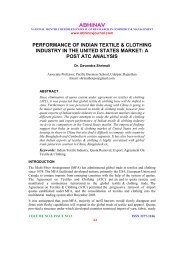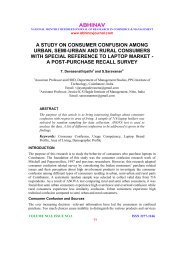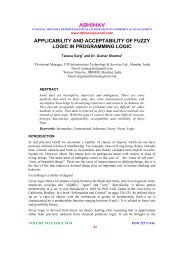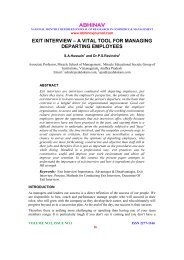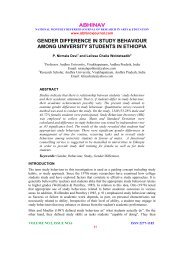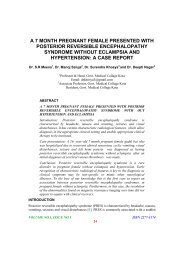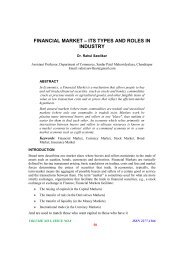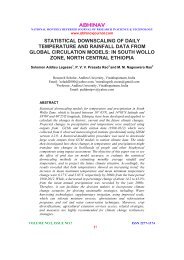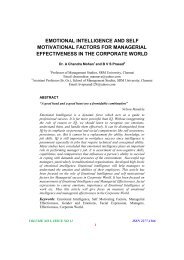Success Through Strategies In Cross-border Merger & Acquisition
Success Through Strategies In Cross-border Merger & Acquisition
Success Through Strategies In Cross-border Merger & Acquisition
Create successful ePaper yourself
Turn your PDF publications into a flip-book with our unique Google optimized e-Paper software.
SUCCESS THROUGH STRATEGIES IN CROSS-BORDER MERGER & ACQUISITIONBhavesh Chadamiya 1 and Mital Menapara 2Assistant Professor, Om Vindhyavasini College for IT & MGT.,Saurashtra University, RajkotEmail: 1 bp_patel84@yahoo.co.in, 2 menparamital@yahoo.co.inABSTRACTAs the markets are becoming global, activity in mergers and acquisitions(M&A), particularly cross-<strong>border</strong>, is booming. The traditional internal ororganic growth model has given way to an aggressive market-based externalgrowth model. Globally, the number and size of deals is heading towardrecord levels, with cross-<strong>border</strong> deals taking centre stage, as companiestake advantage of cheap financing to pursue their expansive M&Astrategies.This research paper starts with the introduction of M&A in <strong>In</strong>dia with somefigures and end with conclusion. This paper is concentrated particularly onthe various strategies which the <strong>In</strong>dian as well as overseas companies canleverage in their cross-<strong>border</strong> merger and acquisition processes which formthe main part of this paper.Keywords: <strong>Merger</strong> & <strong>Acquisition</strong>, <strong>Cross</strong> Borders of M&A, AnalyzeCompany Culture, Handel to People, M&A Communication.INTRODUCTIONIt is the inherent desire and need of every business to grow both vertically and horizontally.Organic growth, that is development from within, is often slow and sometimes difficult. Thatis why there is an increasing trend towards M&A. It could be called an instant expansion.Most <strong>In</strong>dian companies have followed an inorganic route to expand their overseasoperations. The number of cross-<strong>border</strong> deals has increased from 30 in 1995 to 71 in 2000and 410 in 2011.According to report by Grant Thornton, the number of cross-<strong>border</strong> deals from <strong>In</strong>dia in 2011grew much faster than domestic deals. There were 480 M&A deals in <strong>In</strong>dia last year with atotal value of about $20.3 billion. Of these 266 were cross-<strong>border</strong> deals (value $15.3 billion).The targeted firms are being used US and EU as platforms to gain access into these foreignmarkets by leveraging the market positions already established by these firms on theirrespective domestic turfs. From 1995 to August 2006, 29 percent of <strong>In</strong>dian cross-<strong>border</strong>M&As occurred in the European Union and 32 percent in North America.VOLUME NO.1, ISSUE NO.6 ISSN 2277-116630
ABHINAVNATIONAL MONTHLY REFEREED JOURNAL OF REASEARCH IN COMMERCE & MANAGEMENTwww.abhinavjournal.com<strong>In</strong>dians are taking over more <strong>In</strong>dian companies abroad than MNCs (multinationalcompanies) are taking over companies in <strong>In</strong>dia. The sectors that held sway in these dealsinclude Engineering, IT and IT - enabled services, Media, Pharmaceuticals & Healthcare andTextiles.<strong>Cross</strong>- Border <strong>Merger</strong> & <strong>Acquisition</strong> <strong>Strategies</strong>Many <strong>Merger</strong>s and <strong>Acquisition</strong>s have failed across all industries. These failures are notusually caused by outside factors like the market, competition, high purchase premiums orexcessive leverage. Rather, the failures have three primary causes: incongruent managementstyles, organizational culture differences and clashes in decision-making processes.Dissatisfied customers, communication problems, cultural cohesion problem, decisionmaking problem, employee attrition, decreased productivity are the most distressing aspectof managing a post merger or acquisition operations of business. At that time, it becomesvery difficult for companies to solve those problems. For this reason, the solution tomanaging these transactions depends largely on planning and prevention.Here some real-life strategies are given which can help the companies to act on before thecross-<strong>border</strong> M & A deal is inked.Cultural Cohesion: Analyze Company Cultures<strong>In</strong> today’s competitive global business landscape, the increasing number of M&A dealsacross cultures has presented companies with a whole new set of opportunities andchallenges to consider as they attempt to integrate the business strategies, operations, andcultures of the different companies. The organizational culture plays an important role duringmergers and acquisitions as the organizational practices, managerial styles and structures to alarge extent are determined by the organizational culture.The importance and bottom-line impact of the cultural component in cross <strong>border</strong> M&Adeals is still unappreciated and underestimated when compared to the other operational,management, and business strategy issues that so often dominate the discussions andintegration planning in the corporate offices.During the courting phase, companies considering consolidation must maintain objectivityabout the impending business deal. Companies should frankly discuss their respectivebusiness cultures to determine whether an appropriate fit is even possible. Distinctdifferences must be acknowledged, accepted and dealt with directly. An open and honestassessment of the differences in business cultures ensures there are no surprises after the twocompanies begin working together.HR: Handle the People part of M & AAlthough the merging entities give a great deal of importance to financial matters and theoutcomes, HR issues are the most neglected ones. Companies typically amass an army offinancial advisors and lawyers but lack the expertise to handle the people part of M & A.Ironically studies show that most of the mergers fail to bring out the desired outcomes due topeople related issues. The uncertainty brought out by poorly managed HR issues in mergersand acquisitions have been the major reason for these failures.VOLUME NO.1, ISSUE NO.6 ISSN 2277-116631
ABHINAVNATIONAL MONTHLY REFEREED JOURNAL OF REASEARCH IN COMMERCE & MANAGEMENTwww.abhinavjournal.comTo successfully merge two companies, executives need to allocate sufficient communicationresources for managing employee concerns. <strong>In</strong>dustry consolidation typically raises fearsabout job loss, plant relocation or the reassignment of responsibilities. Managers must behonest with their people about what to expect. Management must also involve their staff inas much decision-making as possible.Frequently, the smartest strategy is to bring in a trusted advisor who is skilled in handling thehuman aspects of mergers and acquisitions. After all, companies are made up of people andpeople determine performance. Putting people first is an investment in success.Beware the Honeymoon SyndromeSpirits are usually high at the onset of the merger or acquisition. Stock prices skyrocket,press is favorable and expectations are high for growth. This is the “honeymoon period”when companies are preoccupied with the bright side of the new venture. This can also be avery dangerous time, as companies are blind to the weaknesses and risks inherent in the deal.Often it’s wise to bring in an objective third party as the planning begins to prevent‘infatuation’ and ensure that management is realistically considering the problematic aspectsof the merger or acquisition.It’s also critical to gauge whether management is willing to allocate enough “bandwidth” totackle both the acquisition and current operations. It is important to perform "reversequalification" so companies use the same set of analytical tools on themselves that they havealready used on the target company.Asking the following questions will help determine whether both organizations are truly fitor not.“Does the new company treat customers the same way?”“Do we share similarities in risk taking?”“Does the new company nurture leadership qualities in their management staff?”Sometimes no deal is the best dealSometimes the best deal is the one that never happens. If there is problem in findings theinterest of both the parties in the merger or acquisition, it is better to stop that process at thattime only. For example, the recent decision of Land O’Lakes and Swiss Valley Farms toindefinitely postpone their intended fluid milk joint venture. Both companies analyzed waysto come together and decided the venture would not work in both cooperatives’ bestinterests. Although the venture did not fly, the companies’ reluctance might be deemed asuccess. A failed merger can cost a company millions of dollars, often resulting in hugeemployee turnover and customer dissatisfaction<strong>Merger</strong> & <strong>Acquisition</strong> CommunicationsClearly defined communication strategy during M &A plays an important role in removingthe employee fears and kill rumors floating around in the organization. Studies show thatcommunication strategy that involves senior managers of the acquired organizations workwell. The employees meeting in small groups so as to discuss their concerns, fears andpositive feelings also helps to lessen the stress on employees of acquired firm. This alsoVOLUME NO.1, ISSUE NO.6 ISSN 2277-116632
ABHINAVNATIONAL MONTHLY REFEREED JOURNAL OF REASEARCH IN COMMERCE & MANAGEMENTwww.abhinavjournal.comprovides confidence to employees that the new management is willing to listen to theirconcerns and feelings, building an atmosphere of mutual trust.The transition period also becomes crucial from communication point of view. <strong>In</strong> case oflengthy transition period the employee stress increases, the best strategy in this period is toconvince the employees that they are part of new organization and their concerns will betaken care of. The transition period can also be used to improve communication with theemployees of acquired firm. Improved communication will help to better understand eachother’s cultures and practices. Firms can also use this period to analyze the human capital ofthe acquired firm and define their possible roles in the new organizations. The transitionperiod provides ample opportunity to design the new organization, explain the new roles tothe employees, plan synergies and train the employees as the new role. This will make theintegration process easier for the acquiring organization.Benefits of Results-Driven Communication include:Retain customer loyalty and brand image, as well as strengthen competitiveadvantage;Retain talented employees and reinforce workforce commitment;Sustain investor confidence;Better prepared to be proactive and capture communication opportunities.Capture synergies and prepare for future venture integration.CONCLUSION<strong>In</strong>dian companies are expanding beyond outsourcing and investment hubs to become globalmarket-shapers through mergers and acquisitions. The increase in major cross-<strong>border</strong>transactions in recent years has been facilitated by the relaxation of regulations on overseascapital movements as well as a supportive political and economic environment.<strong>In</strong>dian companies are able to identify foreign firms that have value-added offerings thatcomplement their own low-cost products and services to create an efficient integrated globalbusiness model—turning the conventional direction of such deals on its head. But what theyare required to keep in mind are the several aspects of M&A activity considered in the formof strategies. They should consider cultural as well as diversity aspect, communicationaspect, people aspect, honeymoon syndrome aspect and interest and co-operation aspect ofinvolved parties. A successful integration process relies on effective, consistent and regularcommunication, in identifying and valuing of cultural differences, being honest with theemployees and considering problematic aspect of M&A.REFERENCES1. The art of M&A, Stanley Foster Reed2. <strong>Merger</strong> and <strong>Acquisition</strong>. The future of Chine. Gunging. 20023. The complete guide to <strong>Merger</strong> and <strong>Acquisition</strong>. Timothy4. <strong>Merger</strong>s and acquisitions: issues from the mid-century merger - Michael Keenan,Lawrence J. White - Business & Economics - 2003 -VOLUME NO.1, ISSUE NO.6 ISSN 2277-116633





